5 Apps to Identify Wood by Picture (Android & iOS) in 2024
Wood identification is a big deal, especially when you’re in industries like woodworking, construction, furniture making, and conservation. Trust me, I’ve been there! Knowing the type of wood you’re working with can make all the difference. But here’s the catch.
Top 5 Apps to Identify Wood by Picture :
1. Forest Tree Identification

Forest Tree Identification is a fantastic app that has become my go-to tool for identifying trees in the wilderness. With its user-friendly interface and extensive database, this app never fails to impress me.
Whether I’m hiking through the woods or simply curious about a tree in my backyard, all I have to do is take a clear picture of its leaves, bark, or overall appearance, and Forest Tree Identification does the rest.
Pros:
- Easy-to-use interface
- Extensive database covering a wide range of tree species
- Accurate identification results
- Interactive map feature for locating trees
Cons:
- Limited compatibility (currently available only on iOS)
2. PlantSnap – Identify Plants

PlantSnap is like having a botanist right in your pocket! This app amazed me with its ability to identify plants from just a photo.
From flowers and shrubs to exotic plants, PlantSnap covers them all.
Pros:
- Wide variety of plant species covered
- Quick identification results
- The educational information provided alongside identifications
Cons:
- Some users reported occasional inaccuracies with certain rare or uncommon plants
3. Nature ID

Nature ID has quickly become my favorite companion during my outdoor adventures!
This remarkable app specializes in identifying various elements of nature such as birds, insects, fungi, and more.
What impressed me the most about Nature ID is its comprehensive database that encompasses a vast range of species.
The app’s advanced algorithms analyze your photos to quickly provide accurate identifications along with detailed information about each organism.
Pros:
- Wide coverage of different organisms
- Accurate identifications
- User-friendly interface
Cons:
- Some users mentioned occasional lagging in performance
- These apps have truly revolutionized the way I explore and understand the natural world around me
4. I.D. Wood

I.D. Wood is a game-changer when it comes to identifying different types of wood.
As an avid DIY enthusiast, this app has become my trusted companion in determining the species of wood for my projects.
What sets I.D. Wood Apart is an extensive database that covers a wide range of wood species from around the world. With just a simple photo, this app provides accurate identifications by analyzing the grain patterns, textures, and color variations unique to each type of wood.
Pros:
- A comprehensive database covering numerous wood species
- Accurate identification based on visual attributes
- Detailed information was provided for each identified wood
Cons:
- The occasional difficulty in distinguishing between similar-looking woods
5. PlantNet Plant Identification

PlantNet Plant Identification brings botanical knowledge right to your fingertips! This incredible app allows me to identify plants with ease wherever I go – from beautiful flowers in gardens to wild plants during hikes.
The key highlight of PlantNet lies in its vast plant library containing thousands of species globally.
By uploading photos or capturing images directly through the app’s interface, users can obtain quick and reliable identifications based on leaf shapes, flower characteristics, and more.
Pros:
- Extensive plant library encompassing various regions
- Swift identification results using image analysis technology
- A collaborative platform for sharing observations
Cons:
- Some rare or less-known plant species may not be included yet
.
Traditional Methods vs. Modern Technology
As I delved into the world of wood identification, I discovered that there are two distinct approaches: traditional methods and modern technology.
Let’s explore these methods in detail to understand their strengths and limitations.
Traditional Methods:
1. Visual Inspection and Comparison Techniques
When it comes to identifying wood species traditionally, visual inspection plays a crucial role. By closely examining the grain patterns, color variations, and texture of a piece of wood, experts can make educated guesses about its species.
This method relies heavily on experience-based knowledge accumulated over years of working with different types of wood.
2. Utilization of Reference Books and Manuals
Reference books and manuals have long been trusted resources for identifying various wood species.
These comprehensive guides provide detailed descriptions, photographs, and illustrations that aid in matching the characteristics observed in a given sample to known species.
3. Experience-Based Knowledge
Seasoned professionals who have spent years honing their craft often develop an intuitive sense for identifying different types of wood through hands-on experience alone.
They rely on their deep understanding of each species’ unique features acquired from countless encounters with various woods throughout their careers.
Modern Technology
1. Introduction to Smartphone Apps for Wood Identification
With advancements in technology, smartphone apps now offer an innovative approach to identifying wood accurately using just a picture!
These apps leverage image recognition algorithms powered by machine learning techniques to analyze key attributes such as grain patterns, textures, colors, or even microscopic details captured in the photo.
2. Advantages Over Traditional Methods (Accuracy & Efficiency)
The use of smartphone apps for wood identification brings several advantages over traditional methods. Firstly, they enhance accuracy by eliminating human error or bias during visual inspections or comparisons.
Secondly, these apps provide quick results within seconds or minutes compared to manual research through reference books which could take hours or days depending on the complexity.
Guidelines on Capturing Clear Photos for Accurate Results
To obtain the best possible identification outcomes, follow these tips when taking photos of the wood.
Good Lighting
Ensure that the wood is well-lit with natural or artificial light to capture clear details. Avoid shadows or glare that may obscure important features.
Focus and Clarity: Tap on the screen to focus your camera before capturing the photo. Keep a steady hand or use a tripod if necessary to avoid blurriness in the image.
Multiple Angles
Take pictures from different angles, showcasing various sides of the wood sample. This helps provide comprehensive information about its grain patterns, textures, and overall appearance.
Include Context
If possible, include additional elements in the photo that can help establish scale or context for size comparison purposes.
For example, you could place a coin next to a small piece of wood or include your hand in the frame while holding a larger sample.
Limitations of Apps
1. Factors Affecting Accuracy
While these apps strive for accuracy, certain factors can affect their performance. Lighting conditions play a crucial role – poor lighting or excessive glare may hinder the accurate analysis of wood characteristics.
Additionally, image quality plays a significant part in obtaining precise identifications. Blurry or low-resolution photos might result in less accurate results from the app algorithms.
2. Database Limitations
Although smartphone apps boast extensive databases, it’s essential to remember that not all wood species may be included.
While they cover numerous common and well-known species, rare or uncommon woods might not be present in the database at this time.
Challenges Faced During Identification Process:
1. Similar-Looking Wood Species Confusion
One challenge faced during wood identification is distinguishing between similar-looking species. Some woods share comparable grain patterns or color variations that make differentiation challenging even for experts. This complexity can pose difficulties when relying solely on visual cues provided by smartphone apps.
2. Variability Within a Single Species
Wood variability within a single species presents another challenge during identification efforts.
Growth conditions, such as soil type, climate variations, or aging effects like weathering or insect damage can lead to inconsistencies in appearance among samples of the same species.
This variation adds an extra layer of complexity when attempting to identify specific types of wood accurately.
Frequently Asked Questions
1. Can these apps accurately identify any type of wood?
While smartphone apps for identifying wood by picture are highly advanced, their accuracy may vary depending on factors such as lighting conditions and image quality.
2. How do these apps work?
These apps utilize image recognition algorithms powered by machine learning techniques to analyze key attributes of the wood captured in a photo.
3. Do I need an internet connection to use these apps?
Most of these identification apps require an internet connection because they rely on accessing a vast database stored online.
4. Can I trust the identifications provided by these apps?
While these apps can provide accurate identifications for many types of wood, it’s always recommended to cross-reference the results with additional resources like expert advice or reference materials if precision is crucial for your specific project.
5. Are there any limitations when using these identification apps?
Yes, there are certain limitations to consider when using identification apps for wood analysis purposes. Factors affecting accuracy include lighting conditions during photography and the quality of images captured – clear photos yield better results.
Conclusion
these wood identification apps offer numerous benefits compared to traditional methods. They provide accuracy and efficiency by utilizing advanced image recognition technology.
I encourage users to explore these recommended apps further as they can enhance their wood identification skills, making the process more efficient and enjoyable.




